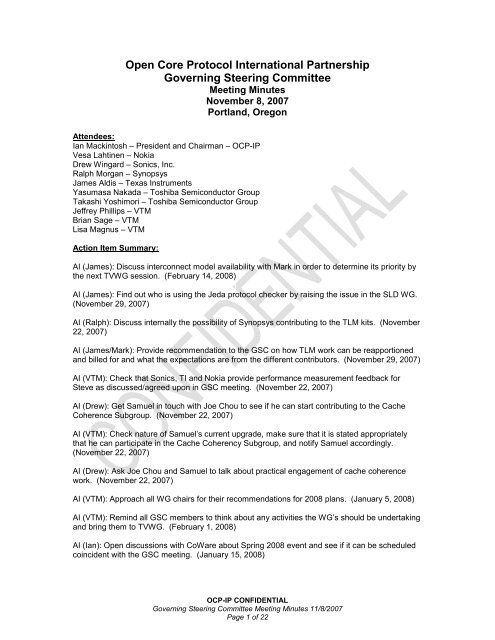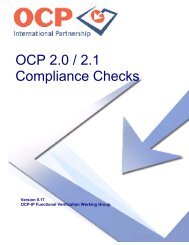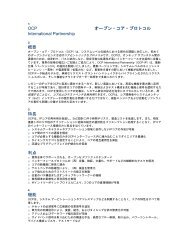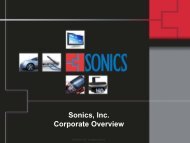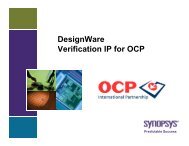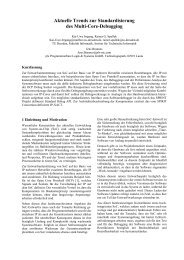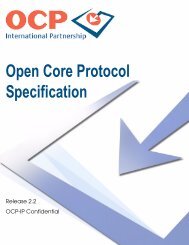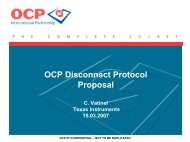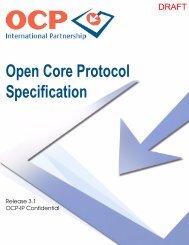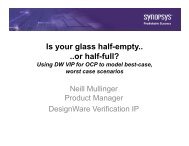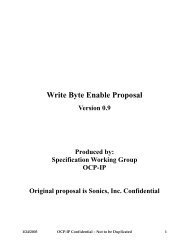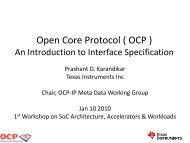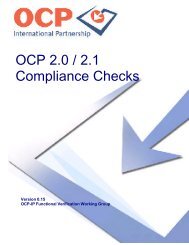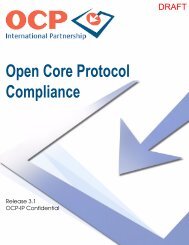Open Core Protocol International Partnership Governing ... - OCP-IP
Open Core Protocol International Partnership Governing ... - OCP-IP
Open Core Protocol International Partnership Governing ... - OCP-IP
You also want an ePaper? Increase the reach of your titles
YUMPU automatically turns print PDFs into web optimized ePapers that Google loves.
<strong>Open</strong> <strong>Core</strong> <strong>Protocol</strong> <strong>International</strong> <strong>Partnership</strong><strong>Governing</strong> Steering CommitteeMeeting MinutesNovember 8, 2007Portland, OregonAttendees:Ian Mackintosh – President and Chairman – <strong>OCP</strong>-<strong>IP</strong>Vesa Lahtinen – NokiaDrew Wingard – Sonics, Inc.Ralph Morgan – SynopsysJames Aldis – Texas InstrumentsYasumasa Nakada – Toshiba Semiconductor GroupTakashi Yoshimori – Toshiba Semiconductor GroupJeffrey Phillips – VTMBrian Sage – VTMLisa Magnus – VTMAction Item Summary:AI (James): Discuss interconnect model availability with Mark in order to determine its priority bythe next TVWG session. (February 14, 2008)AI (James): Find out who is using the Jeda protocol checker by raising the issue in the SLD WG.(November 29, 2007)AI (Ralph): Discuss internally the possibility of Synopsys contributing to the TLM kits. (November22, 2007)AI (James/Mark): Provide recommendation to the GSC on how TLM work can be reapportionedand billed for and what the expectations are from the different contributors. (November 29, 2007)AI (VTM): Check that Sonics, TI and Nokia provide performance measurement feedback forSteve as discussed/agreed upon in GSC meeting. (November 22, 2007)AI (Drew): Get Samuel in touch with Joe Chou to see if he can start contributing to the CacheCoherence Subgroup. (November 22, 2007)AI (VTM): Check nature of Samuel’s current upgrade, make sure that it is stated appropriatelythat he can participate in the Cache Coherency Subgroup, and notify Samuel accordingly.(November 22, 2007)AI (Drew): Ask Joe Chou and Samuel to talk about practical engagement of cache coherencework. (November 22, 2007)AI (VTM): Approach all WG chairs for their recommendations for 2008 plans. (January 5, 2008)AI (VTM): Remind all GSC members to think about any activities the WG’s should be undertakingand bring them to TVWG. (February 1, 2008)AI (Ian): <strong>Open</strong> discussions with CoWare about Spring 2008 event and see if it can be scheduledcoincident with the GSC meeting. (January 15, 2008)<strong>OCP</strong>-<strong>IP</strong> CONFIDENTIAL<strong>Governing</strong> Steering Committee Meeting Minutes 11/8/2007Page 1 of 22
AI (Ian): Research potential <strong>OCP</strong>-<strong>IP</strong> membership from Russia with S<strong>IP</strong>/semiconductor-basedcompanies and plan trip if applicable. (December 8, 2007)AI (Ian): Ensure the benchmarking part of the NoC specification appropriately promotes <strong>OCP</strong>versus alternatives. (December 2, 2007)AI (Drew): Forward email containing Toshiba’s write model extension proposal to Ralph.(November 10, 2007)AI (Ralph): Provide feedback on Synopsys’ posted write position. (November 16, 2007)AI (Nakada-san): Confirm discussion between Toshiba and Sonics will occur within two weeks.(November 16, 2007)AI (Drew): Take vote on posted write issue within 2 ½ weeks. (November 22, 2007)AI (Drew/James): Have power management discussion closed within three weeks. (November29, 2007)AI (Nakada-san): Provide <strong>OCP</strong>-<strong>IP</strong> with English language STIL (Standard Test InterfaceLanguage) guide. (November 29, 2007)AI (VTM): Pass STIL (Standard Test Interface Language) guide to Steve to evaluate opportunitiesfor collaboration. (November 29, 2007)AI (Nakada-san): Provide GSC with a description of the scope of STARC’s System Level DesignTechnologies Group. (December 6, 2007)AI (VTM): Pass the description of the scope of STARC’s System Level Design TechnologiesGroup to Mark and James so they can evaluate opportunities for collaboration. (December 12,2007)AI (Nakada-san): Provide update on quality and status of VDEC converter tool at next GSCmeeting. (February 14, 2007)AI (VTM): Review Cache Coherence goals as stated next time, to make sure they are consistentwith what has already been reported. (February 13, 2008)AI (VTM): Review Debug goals as stated the next time, to make sure they are consistent withwhat had already been reported. (February 13, 2008)AI (VTM): Evaluate Multicore Spring seminar in the US and the value of attending it againstavailable funds (January 15, 2007).AI (VTM): Evaluate possible attendance cost/benefits of ARM developer conference in Fall 2008.(April 1, 2007)AI (Ian): Talk with Steve about participation levels in the FVWG. (January 5, 2008)AI (Ian): Re-approach Tom Andersen and ask for feedback regarding interest in FVWGparticipation and the development of something to validate OVM strategy. (November 22, 2007).AI (Ian): Ask Brophy when Mentor will define the precise contents of phase 2 and ask if he willentertain a discussion about the value of incorporating <strong>OCP</strong>-related work to more rapidly growtheir appeal to a larger community. (November 29, 2007)<strong>OCP</strong>-<strong>IP</strong> CONFIDENTIAL<strong>Governing</strong> Steering Committee Meeting Minutes 11/8/2007Page 2 of 22
AI (VTM): Allow debug specification to go directly into member review following criticalacknowledgement of quality from Texas Instruments and Nokia and the more active DebugWorking Group members. (4Q07)AI (VTM): Call a meeting to occur within mid-December to discuss an <strong>OCP</strong>-<strong>IP</strong> collaboration tomake progress with SPIRIT; attendees must be Mark Knoll, Ralph, Drew, Vesa, Maaroui, Ian, andJames. (November 22, 2007)AI (Drew): Check if Sonics has grounds to send a letter of disapproval to VSIA and follow up withVSIA appropriately. (November 29, 2007)AI (Vesa): Check if Nokia has grounds to send a letter of disapproval to VSIA and follow up withVSIA appropriately. (November 29, 2007)AI (VTM): Notify Greensocs that they are the <strong>OCP</strong>-<strong>IP</strong> Contributor of the Year for 2007.(November 15, 2007)AI (Ian/Joe): Explore candidate book editors and look to find ways to get work underway.(December 15, 2007)AI (Joe): Explore interest of other standards bodies to participate in survey. (January 15, 2008)AI (Ian/Joe): Initiate survey. (January 15. 2008)AI (Ian): Consider possible participation and role of Spirit in any collaboration plan we developinternally at <strong>OCP</strong>-<strong>IP</strong>. (December 1, 2007)AI (Ian): Come up with ways to help James promote <strong>OCP</strong>-<strong>IP</strong> within Texas Instruments.(November 22, 2007)AI (VTM): Contact M<strong>IP</strong>S about the possibility of shipping them a set of <strong>OCP</strong>-<strong>IP</strong> newsletters on aquarterly basis. (November 22, 2007)Agendao Call to Order, Introductions, Agenda Review, Last Minutes (Ian)o Annual Governance Resolution & Electionso Next GSC Meeting (Ian)o System Level Design WG Status (James) TLM and SOW discussiono Functional Verification WG Status (Steve)o Motion to Adjourn/ Break/ Reconveneo Technical Vision WG Status / Restated (Ian)o Progress in Asia (Ian)o Debug WG Status (Bob)o NoC BWG Status (Ian)o Specification WG Status (Drew) Posted Write Specification Issue Cache Coherence Subgroup Statuso Motion to Adjourn/ Lunch/ Reconveneo Japan Recruiting Plan (Nakada-san) Maximizing Collaboration with STARCo 2007 Goals (Ian)o AI Review (Ian) ARM Discussion DesignWare and <strong>Core</strong>Creator Updates Notification of Princeton Upgrade<strong>OCP</strong>-<strong>IP</strong> CONFIDENTIAL<strong>Governing</strong> Steering Committee Meeting Minutes 11/8/2007Page 3 of 22
ooooooo Reminder to Request <strong>OCP</strong> interfaces From Vendors VSIA Issue 2007 Outstanding Contributor NominationsPR Update (Joe) <strong>OCP</strong> Book Discussion SummaryRecruiting Update (Joe)2008 Annual Budget (VTM)Administrative Update (VTM)Enabling ResolutionCollateral Review (VTM)Motion to AdjournCall to Order, Introductions, Agenda Review, Last MinutesIan called the 25 th <strong>OCP</strong>-<strong>IP</strong> <strong>Governing</strong> Steering Committee meeting to order at 8:24 AM PST.Ian formally introduced Ralph Morgan of Synopsys to the members of the <strong>Governing</strong> SteeringCommittee (GSC).Ian stated that he wanted to address a unique project that was not on the agenda. Ian said thatthe University of British Columbia had begun an evaluation of a new product from Duolog called“<strong>OCP</strong>-conductor.” Ian said that the group would hear about the findings of this evaluation at, orbefore, the next GSC meeting.Ian reviewed the 25 th <strong>OCP</strong>-<strong>IP</strong> GSC meeting agenda with the group. Ian said that because it wasan annual GSC meeting, it was necessary to go through the annual governance items. Ian statedthat good progress was being made in the Network-on-Chip Benchmarking Working Group (NoCBWG) and they were progressing well. Ian said that the Specification Working Group (SWG)update would include an important discussion about the posted write specification issue. Ian saidthe public relations update would summarize the previous night’s discussion on how to proceedwith the book about <strong>OCP</strong>. Ian said that, later in the meeting, the GSC would need to review andapprove the annual <strong>OCP</strong>-<strong>IP</strong> budget.James asked if the group needed to set goals for 2008 in this meeting. Ian said that they did not,but that they would need to review technical goals.MotionVesa motioned to approve the meeting minutes from the 24 th <strong>OCP</strong>-<strong>IP</strong> GSC meeting held onAugust 23, 2007. Drew seconded the motion. The vote was approved: 5 yeas, 0 nays, 0abstentions.Annual Meeting Saving Resolution (Governance Resolution and Elections)Ian read the Annual Meeting Saving Resolution to the group.MotionDrew motioned that it be resolved that all acts previously taken by any officer of the Corporationon behalf of the Corporation are approved, ratified, and confirmed, provided the acts were notinconsistent with the Corporation’s Articles of Incorporation or Bylaws, the California CorporationsCode, or any other applicable law. James seconded the motion. The vote was approved: 5 yeas,0 nays, 0 abstentions.Ian told the group that two officer elections needed to occur. Ian said that he currently held theposition of Chairman of record, and that Drew held the position of Secretary of record. Ian saidthat he also served as President of <strong>OCP</strong>-<strong>IP</strong> at the pleasure of the board, but this position did notneed to be recognized annually and could be changed at any time at the pleasure of the board.Motion<strong>OCP</strong>-<strong>IP</strong> CONFIDENTIAL<strong>Governing</strong> Steering Committee Meeting Minutes 11/8/2007Page 4 of 22
James reviewed the SLD WG’s status table. James explained that the color red on line one oftable meant that there was no interconnect model. James said nobody was currently working oncreating an interconnect model either. Drew said he thought that the original idea of Greensocsand the Green Bus was to build something similar to the interconnect model and then map it on to<strong>OCP</strong>. James said that Greensocs had built it and was doing XML configuration with SPIRIT, butthat it was not their main motivation. James said that the highest level of abstraction was just arouter that was being used to do <strong>IP</strong> Exact experiments. James went on to say that Greensocs’motivation had always been interfaces like <strong>OCP</strong>. Drew said the TVWG had included this itembecause they believed that it would serve as a useful reference file for the community. Drewasked if Mark was de-emphasizing it in his planning. James replied that he did not think that itwas ever in his plans. James went on to say that there may be a disconnect between Mark andthe TVWG. James asked if <strong>OCP</strong>-<strong>IP</strong> really needed this. James said that it could be a Greensocswork item, which could then be linked to the <strong>OCP</strong>-<strong>IP</strong> Web site. Drew said the interconnect modelwould be another deliverable made available to the community. James said this item wassomething to raise at the start of the next year. Drew said he encouraged James to speak withMark about it in the meantime.AI (James): Discuss interconnect model availability with Mark in order to determine itspriority by the next TVWG session. (February 14, 2008)James said that the second line in the table, simulation performance, had been completed, butthe status column had not yet been updated. James said the SLD WG had performed afeasibility study on the third line, the functional versus implementation separation. James saidthey had looked at how the SystemC code was being organized so that there could be morereuse between different layers of abstraction. James went on to say that it was done in thecontext of a study, not to change the code. James said that the fourth item in the table,abstraction layers, had the same status. James said that he had many discussions with Jeda onthe SystemC protocol checker on line five. Drew asked if this was what Jeda had released as aproduct. James said that Jeda released a TL1 protocol checker at the RTL level. James saidthat it could tie to the TL1 channel in SystemC. James went on to say that <strong>OCP</strong>-<strong>IP</strong> members hadaccess to one version, which was smaller than the product version. James said that it was a sortof bait. Drew asked if this was a useful deliverable. James said that Texas Instruments had beenworking with Jeda on their product side, and had no experience with what they put into <strong>OCP</strong>-<strong>IP</strong>.Drew said that Sonics was working with Jeda on the product side as well. Drew said that it was ared flag if nobody knew anyone who was using the Jeda protocol checker.AI (James): Find out who is using the Jeda protocol checker by raising the issue in theSLD WG. (November 29, 2007)James said that line number six was a functional review, which was related to what the SLD WGhad been working on previously. James said this was a drive of the <strong>OCP</strong> functional viewthroughout the industry. James went on to say that OCSI was about to release a TLM model thatwas a functional view of what a memory map bus was conceptually. Vesa asked James if he washappy with what was coming out. James said he was. James said that this moved him on to thenext line dealing with collaboration. James said that there were six things that needed beresolved before the public release of the OSCI TLMs. James said that the second draft releaseof TLM 2 had received a negative public review. James said that in his opinion the last versionwas much better than what was released a year ago. James said that it met the TexasInstruments’ world view, and that which Greensocs had also been propagating. James went onto say that one of the reasons <strong>OCP</strong> was interesting to people was because of its configurability.James added that a large portion of <strong>OCP</strong> could be modeled at a functional level. Drew askedJames if what came out of OSCI would be a layer above what had been done in <strong>OCP</strong>-<strong>IP</strong>, and if arefinement downward to lower levels of abstraction would be as straightforward as possible.James said that this was possible and that it was exactly what he wanted. James went on to say<strong>OCP</strong>-<strong>IP</strong> CONFIDENTIAL<strong>Governing</strong> Steering Committee Meeting Minutes 11/8/2007Page 6 of 22
that there was a deadline for the OSCI release. James said that the intention was to have atomictransactions in the release, but the schedule had so far not allowed that.James said that the SLD WG was in good shape with OSCI. James said that they had a voice,had an overlap in membership, and were providing valuable input to OSCI. James said thatSPIRIT was the opposite, and that they had no idea what was going on inside that group. Jamessaid that only CoWare was in both groups. James said that SPIRIT did not seem to beprogressing quickly or in the right direction. James said that SPIRIT was looking for ways todocument interfaces and levels of abstraction. Drew said that there would be a discussion onSPIRIT later in the meeting.James said that the last item in the status table was regarding the NoC BWG. James said that atthe moment it looked easy for the SLD WG to align on nomenclature and they could implementthings in SystemC that would make the performance measurement visible. James went on to saythat any deeper interaction was not being strongly pursued at the moment. James said thatpeople in the SLD WG were reviewing documents from the NoC BWG and that people wereinterested, but at the moment the SLD WG did not see clear goals to work towards. Ian addedthat Mark was active in the NoC BWG.James said that the SLD WG wanted to upgrade their entire kit to reflect a style of modeling beingproposed by Greensocs and OSCI, and in order to make it simpler, faster, and easier to maintain.Ian said that the GSC needed to decide what to do about the TLM kits. James passed out copiesof the Greensocs proposal that the GSC had been voting on. James said that Greensocs did afeasibility study, based on the ideas of Green Bus, to improve the quality of the system design kit.James said that the proposal included general improvements and alignments. James added thatat higher levels this was aligned with OSCI. Ian said that the original Statement of Work wasindeed well aligned with OSCI and all GSC members had been asked to pay for a piece. Ianwent on to say that in reviewing the votes, Texas Instruments and Toshiba had voted yes, Vesasaid he had to get back in mid-November with an answer because of internal complications,Synopsys said no because they believed there may be other ways of doing this work, and Drewsaid verbally that he was interested in trading work instead of payment. Ian said that there was afairly comprehensive list of things that needed to be done to the kit, but the question was how toget them done.Drew said that Sonics’ view was that this was important work to be done, but that the proposal leftSonics feeling unsatisfied with respect to quality. Drew went on to say that Sonics thought thiswas addressable though. Drew said that he was worried, because Sonics was heavily invested inthe current channels. Drew said Sonics had worked a lot on both the internals and externals, aswell as maintaining the adapters for the last few years. Drew said the big concern was that thisproposal only served <strong>OCP</strong>-<strong>IP</strong> if it was completed to the point of a production design. Drew saidthat in terms of proposed financial arrangements, Sonics’ counter-proposal would be ‘work inkind’ and they would continue to do the adapter maintenance. Drew said that Sonics volunteeringto do the adapters would be approximately 1/5 of the budget. Drew said that Sonics relied moreheavily than others on the adapters. Ian said that because of slips at SPIRIT and OSCI, thedelay on deciding upon an SLD kit strategy had caused <strong>OCP</strong>-<strong>IP</strong> problems yet. Ian added that thework needed to get underway as soon as possible. Drew reiterated that there could becontributions in kind and that a clause in the proposal said that Greensocs did not have to do allof the work themselves.James said that Texas Instruments had had a relationship with Greensocs for almost two yearsand they pay them to be in the SLD WG. James went on to say Texas Instruments was happywith Greensocs’ work. James said that one of his motivations for favoring Greensocs was RobertGuenzel. James said that Robert was a person who was very familiar with <strong>OCP</strong> and whohappened to be looking for a project at the moment, which he could turn into his PhD thesis.James said he believed that Robert’s work would be very high quality. Drew said that fromSonics’ perspective there was no issue in giving Greensocs money. Drew said that this needed<strong>OCP</strong>-<strong>IP</strong> CONFIDENTIAL<strong>Governing</strong> Steering Committee Meeting Minutes 11/8/2007Page 7 of 22
to be well thought out because it would be the biggest financial commitment to technical work<strong>OCP</strong>-<strong>IP</strong> had ever made.Ian asked the group how to break the deadlock. Ian said that this should not be a problem, butan opportunity to develop and maintain world class TLM kits going forward. Ralph said that hisposition was supportive for <strong>OCP</strong>-<strong>IP</strong> to supply kits. Ralph went on to say that in the interest offiscal responsibility Synopsys would want to see this proposal go out for a competitive bid.James said that the proposal could be turned into a request for a quote. Ralph said that this wasoutside of his area of expertise. Ralph said he spoke with Synopsys’ ESL group, and that theyworked with a company called SLX. James said that SLX had worked closely with Greensocs inthe past. James said there were only about five companies in the world that did SystemCtechnical projects. James said that people within Synopsys could probably be found to do thisproject. Ralph said that he should bring up the possibility of Synopsys doing some of the work, aswell. Ian asked if it was possible to have the job done inside of Synopsys. Ralph said that it waspossible, but he needed to explore the potential.AI (Ralph): Discuss internally the possibility of Synopsys contributing to the TLM kits.(November 22, 2007)Ian asked Vesa what Nokia’s position on Greensocs’ proposal was. Vesa said that this issue hadnot received the necessary attention due to Nokia’s reorganization. Vesa said he was fine withthe technical side, but he was unclear who inside Nokia was responsible for related fiscaldecisions at this point. Vesa said he was told that by mid-November it would be clearer and adecision could be made at that time. Drew asked Vesa if, hypothetically, a decision was madetoday for each company to fund a portion would this be a problem for Nokia. Vesa replied that hewas not ready to comment yet. Ian asked if the GSC thought other bids were needed. Drew saidthat if another company was close in price to Greensocs that the GSC should go with Greensocs.Ian said that they would go with Greensocs in that case, and he added that with Mark being thechair of the SLD WG, the bid was hard to walk away from.James said that they were beginning to look at a project where there were resources fromToshiba, Texas Instruments, and hopefully Nokia. James went on to say that people who wereemployees of Greensocs provided a significant amount of other resources. James said thatSonics and CoWare could likely provide people and not money. James said that they would needa project manager in this case. Drew asked what would happen if a competitive bid came in athalf price. Drew asked what it would do to Mark. Drew said that Mark was being paid by TexasInstruments and was doing a competent job of driving the SLD WG. Drew went on to say that ifthey made a decision that would demoralize him, the group needed to take that intoconsideration. James asked what the agreement between <strong>OCP</strong>-<strong>IP</strong> and Mark is. Ian said that intrade for Mark being the chair of the SLD WG, Greensocs was given a free Sponsor membershipin <strong>OCP</strong>-<strong>IP</strong>. Ian said that he did not want Mark to be alienated, but some people could contributemoney, and others could contribute help. Ian said that they could have Mark be the generalcontractor that put it all together. Ralph said that he did not want to overcomplicate the issue andthat if Mark was the best person, Synopsys would support the proposal. Ralph said he would goback and see if there was work Synopsys could do in lieu of a contribution of money. Jamesreiterated that the open issues were the work split and CoWare, Sonics, and Synopsys possiblycontributing in kind. James said that they also needed to get an answer from Nokia. Drewrestated that Sonics was offering to do the adapter work. Ian said that Mark would be the bestperson to figure out what contributions are practically realistic. Ian said that they could tell Markthat they conceptually wanted to proceed with the work. Ian said that there were issues aboutcontributions or money from Synopsys, and that they would not hear a resolution from Nokia untilthe 15 th of November. Ian said they needed to ask Mark to put together a complete work plan sothat the GSC knew what to expect from everyone. James wanted to know if there was somethingthat they could do immediately. James said that Texas Instruments would like to be billed in 2007for this work or else there was a risk of the funds having to be re-approved in 2008. Ian saidthere was no problem taking payment and quickly staging distribution of payouts for work. James<strong>OCP</strong>-<strong>IP</strong> CONFIDENTIAL<strong>Governing</strong> Steering Committee Meeting Minutes 11/8/2007Page 8 of 22
said they could start with the resources they had from Texas Instruments and Toshiba. Jamesasked if they needed to get an answer from everyone, or could they start moving forward. Iansaid that before engaging in work, Mark needed to redo his Statement of Work, including hisassumptions for specific for contributions. Ian said that it might take a couple of weeks to tiedown CoWare and Synopsys, and that by then Nokia should have a plan also.Drew stated that configuration-dependant testing was not one of Mark’s skills. James said thatthe SLD WG had added pre-release testing into the kit last year. James said that there was nodecent quality regression for the adapter code though. Ian said that the responsibility for thiswas not squarely on James as the architect and Mark as the manager. Ian told James to prodhim if James ever needed any help developing a new SoW with Mark. Ian said the onlychallenge he saw was redoing the Statement of Work into something that can be practicallyimplemented with multiple collaborations. Ian asked James if this approach was unreasonable.James said this was not and that the SLD WG should remain the arbiter. James said thatnumerous day-to-day technical decisions would need to be made but that all major decisionswould be made in the SLD WG.AI (James/Mark): Provide recommendation to the GSC on how TLM work can bereapportioned and billed for and what the expectations are from the different contributors.(November 29, 2007)James said it would be difficult to detail a level of legal protection in the revised Statement ofWork. Drew told James that Sonics’ was proposing to contribute section 1.1.3 of the proposal.James said that they would need Nokia and Synopsys to tell them what their positions were assoon as possible. James said that a new Statement of Work in three weeks could be tricky asMark would not be back from vacation until November 20 th . James restated that he wasconcerned about getting an invoice from <strong>OCP</strong>-<strong>IP</strong> before the end of the year. Ian told James thatthe GSC would redistribute the revised Statement of Work, get formal approval and then billTexas Instruments. Ian said that this project was a hybrid that <strong>OCP</strong> had never done before, butthat it was a very good thing and appeared doable. Ian said that, conceptually, they knew whateveryone was doing. Ian said that the SLD WG has had a very high-quality product for a numberof years. James said that people inside OSCI listened to what <strong>OCP</strong> had to say, because theyhad been doing it for a long time. Ian said that by the end of 2008, <strong>OCP</strong>-<strong>IP</strong> would have thehighest quality kits in the world with successful definition and implementation of this proposednew SoW and work.Functional Verification Working Group StatusSteve McMaster joined the meeting at 9:37 A.M. PST.Steve addressed the Functional Verification Working Group’s (FVWG) recent activities. Stevesaid that the main thing the FVWG had been working on was the performance standard. Stevesaid the FVWG had discussions with the SLD WG early in the year. Steve said that they hadoriginally planned on having something in September, but that they were currently not makingmuch progress. Steve told the group that they had agreed on basic concepts, generated a list ofthings they wanted to cover and sent it to other working groups, but not much feedback had beenreceived. Steve said that one area that was not covered was throughput. Steve said that he hadsent out a discussion of throughput, but that he had gotten even less feedback on this documentthan he had on the performance standards. Steve said the FVWG would not implement anythingwithout receiving feedback first. James asked if by throughput Steve meant bandwidth. Jamessaid that he had read the proposal, but had not yet sent feedback. Steve said he was talkingabout how much could actually be pushed through the system. Steve said that what was in therecurrently should be covering latency, the expected delays and the minimum and maximum onewanted to allow for transaction phases. James said that latency was in there, but bandwidth wasnot. Drew said that he was trying to get the SWG to provide feedback to the FVWG on theperformance measurements. Drew said that Steve should get at least one piece of feedback bynext week. Vesa said that he had sent a review of the document already to Steve.<strong>OCP</strong>-<strong>IP</strong> CONFIDENTIAL<strong>Governing</strong> Steering Committee Meeting Minutes 11/8/2007Page 9 of 22
Ian said that the FVWG did not have enough support. Ian said that, despite this, everything theFVWG needed to release had been released. Ian went on to say that these performancemeasurements were breaking new ground, and people may not understand the significance of it.Ian said that it was not uncommon to not have volunteers. Vesa agreed that performancemeasurements were important and added that Nokia was doing something similar within theirPSL. Vesa went on to say that Nokia was unable to participate in the FVWG, but they followedthe work closely and were interested in what was going on. Ian asked if there would be feedbackfrom three companies in the next week or just two. Drew said that there should be feedback fromSonics, Texas Instruments and Nokia. James said that he would give personal feedback. Drewtold Steve to ask Christophe from Texas Instruments for feedback as well. Steve told the groupthat if he could get feedback on both the performance measurements and the throughputdocuments it would be helpful. Ian asked if there had been any input from Toshiba. Yoshimorisansaid Toshiba had not provided anything yet.AI (VTM): Check that Sonics, TI and Nokia provide performance measurement feedback forSteve as discussed/agreed upon in GSC meeting. (November 22, 2007)Steve said that another FVWG goal was clean compliance checks. Steve said that they felt goodabout basic protocol compliance, but not about configuration compliance. Steve said that thelevel of attendance they had at the meetings prevented them from progressing. Steve said thatthe errata list would demonstrate that there were a lot of things that needed to be cleaned up.Drew said it was his opinion that there was a lot of fresh text and it was bound to present somechallenges. Drew said that he was concerned about people actually submitting errata and notjust brushing over them. Drew said they should want people who own the document to beconcerned about quality control.Drew said he expected that the functional verification area of <strong>OCP</strong> was in a good state, and thatthere was not a lot of work that needed to be done. Ian told Steve that the GSC had a planningsession scheduled for mid-February at which point they would set working group priorities for thecoming year. Steve said that the main item would be cache coherency. Steve said that somepeople in the FVWG had expressed interest already. Drew said that this was very interesting,and the Cache Coherence Subgroup was currently going through some proving exercises beforetheir release. Drew said that the Cache Coherence Subgroup did not want to release this to theworld until they ran it on two systems. Drew added that Samuel Dellacherie might be interestedin contributing.AI (Drew): Get Samuel in touch with Joe Chou to see if he can start contributing to theCache Coherence Subgroup. (November 22, 2007)James said that he thought Steve was saying that once the Cache Coherence work waspublished there would be a lot of items for the FVWG to examine. Steve agreed, but said thatSamuel could get a head start on that work now. Drew said that in cache coherency, formalverification technology had proven to be quite valuable. Ian asked if it was just Samuel whowanted to contribute to the Cache Coherence Subgroup. Steve said only Samuel hadapproached him.AI (VTM): Check nature of Samuel’s current upgrade, make sure that it is statedappropriately that he can participate in the Cache Coherency Subgroup, and notify Samuelaccordingly. (November 22, 2007)Drew suggested that Samuel may want to contact Joe Chou, chair of the Cache CoherenceSubgroup to ensure that he would not slow down the group’s current progress.AI (Drew): Ask Joe Chou and Samuel to talk about practical engagement of cachecoherence work. (November 22, 2007)<strong>OCP</strong>-<strong>IP</strong> CONFIDENTIAL<strong>Governing</strong> Steering Committee Meeting Minutes 11/8/2007Page 10 of 22
Steve McMaster left the meeting at 10:03 A.M.Motion to Adjourn/Break/ReconveneDrew motioned to adjourn for a break. Vesa seconded the motion. The vote was approved: 5yeas, 0 nays and 0 abstentions. The meeting was adjourned at 10:03 A.M PST.Ian called the meeting to order at 10:23 A.M PST.Technical Vision WG StatusThe group skipped ahead to the TVWG status while waiting for working group chairs to call in tothe teleconference.Ian stated that February 2008 would be the next TVWG planning session. Ian added that theTVWG status was a prioritization process for working group activities.AI (VTM): Approach all WG chairs for their recommendations for 2008 plans. (January 5,2008)AI (VTM): Remind all GSC members to think about any activities the WG’s should beundertaking and bring them to TVWG. (February 1, 2008)Progress in AsiaThe group skipped ahead to the progress in Asia section of the meeting while waiting for workinggroup chairs to call in to the teleconference.Ian reviewed <strong>OCP</strong>-<strong>IP</strong>’s recent progress in Asia. Ian said that there were some Asian standardsmovements underway and that <strong>OCP</strong>-<strong>IP</strong> should try to tie into them when possible. Ian went on tosay that <strong>OCP</strong>-<strong>IP</strong> took part in a successful seminar with CoWare and the Nikkei press in May of2007. Ian said that the seminar was a great success and they were going to do it again in Springof 2008. Ian added that the event was very classy and got great participation. James asked it ifwas possible to align that seminar with the GSC meeting taking place in Tokyo around that time.Drew said it was a good idea and there was a chance that some of the GSC could present at thisevent.AI (Ian): <strong>Open</strong> discussions with CoWare about Spring 2008 event and see if it can bescheduled coincident with the GSC meeting. (January 15, 2008)Ian said that the May 2007 event was very user-based, and suggested that the Spring 2008 eventcould be more product-based.Ian stated that <strong>OCP</strong>-<strong>IP</strong> did a session last year in Taiwan on ESL and there was another eventscheduled for late November in Hsinchu and Tainan, Taiwan that would primarily be on debug.Ian said that the scheduled presenters for that event included himself, ITRI, Sonics, CoWare, andJeda. Ian went on to say that M<strong>IP</strong>S had dropped out due to their worldwide sales conference thatwas taking place at the same time. Ian added that Synopsys also had a scheduled worldwidesales conference at that same time.Ian said that <strong>OCP</strong>-<strong>IP</strong> had frustrations working with organizations in China like SS<strong>IP</strong>EX and CS<strong>IP</strong>.Ian said that he had been told that the way to get into China was by using Taiwan’s influence. Iantold the group that there were three Chinese companies who could credibly be considered to bedoing SoC design: Action Semi, Spreadtrum, and Vimicro. Ian said that both Spreadtrum andVimicro had joined <strong>OCP</strong>-<strong>IP</strong> as Participants in the past quarter. Ian added that Spreadtrum had areal need to join <strong>OCP</strong>-<strong>IP</strong> working groups.<strong>OCP</strong>-<strong>IP</strong> CONFIDENTIAL<strong>Governing</strong> Steering Committee Meeting Minutes 11/8/2007Page 11 of 22
Ian said that <strong>OCP</strong>-<strong>IP</strong> was working with KETI, instead of ETRI, in Korea. Ian added that ETRI areapparently not mainstream to SoC work.Ian told the group that <strong>OCP</strong>-<strong>IP</strong>’s progress in India was frustrating, due to a useless ISA andpolitical issues. Ian said that he had directly approached Mindtree, Tata and Sasken. Ian saidMindtree has not responded, but Tata and Sasken had just joined as Participants. Ian told thegroup that both companies were serious <strong>OCP</strong> users. Ian said that WiPro was looking for <strong>OCP</strong>based<strong>IP</strong>’s, but that they claimed they were not using them when they had talked to him last year.Ian said that there were no plans in Russia. James said that he had been hearing that there wasa huge industry in microelectronics developing in Russia. James said that it might be more inphone manufacturing than semiconductors. Vesa said that the government had made hugecontributions to semiconductors.AI (Ian): Research potential <strong>OCP</strong>-<strong>IP</strong> membership from Russia with S<strong>IP</strong>/semiconductorbasedcompanies and plan trip if applicable. (December 8, 2007)Ian added that <strong>OCP</strong>-<strong>IP</strong> had Web sites in Japanese, Korean, and Chinese languages that wereconstantly kept current with updates of locally relevant news and announcements.Ian stated that <strong>OCP</strong>-<strong>IP</strong> was still staying in touch with VDEC in Japan. Ian said that <strong>OCP</strong>-<strong>IP</strong> maywant to advertise VDEC’s converter product. Ian added that VDEC discussed <strong>OCP</strong> at a recentseminar and they had posted <strong>OCP</strong>-<strong>IP</strong>’s University datasheet on their Web site. Ian said thatthere were a number of large companies that were not members, but he knew were using <strong>OCP</strong>,including Canon, Olympus and Sony. James asked if Sony was spinning off their semiconductorwork. Yoshimori-san said that was what he heard. Ian said that he had no angle on how to workwith STARC, and was relying on Toshiba’s connections and leadership.Ian said that in Taiwan <strong>OCP</strong>-<strong>IP</strong> had a total of five members. Ian said <strong>OCP</strong>-<strong>IP</strong> should look to doanother seminar next year. Ian said he spoke with Alan Su about the next steps in developingplatforms that could spin out membership. Ian said that Taiwan seemed to be a follower market.Ian said that he would be in Taiwan at the end of the month and we will probably see 200 or 300seminar participants.Ian told the group that there were only three members in Korea. Ian said he had heard thatSamsung was asking how to purchase <strong>OCP</strong>-based <strong>IP</strong>s.Ian said that China had a total of eight members. Ian told the group that it was a big deal to getSpreadtrum and Vimicro as members and that a press release should be issued regarding thisachievement. Ian said that China was far behind the rest of the world when it came to standards.Ian said it was valuable to meet and educate the sales forces of member companies about <strong>OCP</strong>-<strong>IP</strong>. Ian said he was having trouble reaching Realtek. Drew said that Sonics could providecontact information for Ian.Ian said there were currently eight Indian members. Ian said that the good news was that Tataand Sasken, who were real users of <strong>OCP</strong>, had recently joined <strong>OCP</strong>-<strong>IP</strong>.Debug Working Group StatusBob Uvacek joined the meeting at 10:30 A.M PST.Bob told the group that the Debug Specification had been delayed. Bob said that thespecification had not yet been put into member review. Bob said an example had been insertedin the text, but that it was not clean enough to distribute. Bob said the Debug Working Group(DWG) had created a proposal, which included a debug example. Ian said that it had beenpreviously agreed upon that once the example was cleaned up and people understood how it tiedinto the <strong>OCP</strong> socket, and after the DWG approved it, the specification would go directly into<strong>OCP</strong>-<strong>IP</strong> CONFIDENTIAL<strong>Governing</strong> Steering Committee Meeting Minutes 11/8/2007Page 12 of 22
member review. Bob agreed that this was the goal. Ian asked Bob how far off the group wasfrom reaching this goal. Ian said he just wanted to make sure that the inclusion of the exampledid not change anything.Bob told the GSC that Sprint’s donations could be ready in mid-2008. Bob said that he spokewith Alan at ITRI and they would be able to publish something by the end of the year. Bob saidthat RTL core examples were included in the text, which showed how to involve registers anddefine transactions. Bob said that Infineon’s donation included support for Sprint’s solution onmulticore debugging. Bob said that the DWG had originally thought this was on the hardwarelevel, but it turned out it to be a standard on the software side, where a debug server wasrunning. Bob said that they would like to standardize on the software. Bob said that the solutionwas to match up with ARM and companies in Europe.Bob said that the DWG’s goal was to publish future debug socket signals. Bob said they wantedto have the specification ready for member review by November 7, 2007. Bob said that this goalwas missed, but the DWG was not far away. Bob said that he had written a signal proposal, buthe needed Albrecht, Neal, and Texas Instruments to agree on it. Bob said that the example wasplanned to be done together, but that it was taken over by the Sprint group. Bob said that whenfinished at the end of 2008, it would have two cores and would connect two different debuggers atthe same time. Bob said <strong>IP</strong> Extreme was already offering MCDS, but the DWG has made noprogress on the development of <strong>OCP</strong> wrappers because of a lack of funds, so a first customerhas to be waited upon.Ian stated that the GSC wanted feedback from Bob and Neal on what to do in regards to the workbeing done at Sprint. Bob suggested that pointers be included to the Sprint work from the debugspecification. Bob added that Sprint would have to support the software side while <strong>OCP</strong>-<strong>IP</strong>supported the hardware side. Ian mentioned that <strong>OCP</strong>-<strong>IP</strong> should stay away from endorsing onesolution and instead it should be referred to as a good example. Drew stated that the debug workneeded to work with Sprint and wondered what compelling event would cause people to beginusing the <strong>OCP</strong>-<strong>IP</strong> debug solution. Bob replied that <strong>OCP</strong>-<strong>IP</strong> members would have to vote on thespecification. Drew said that the linkage with Spirit was likely to either persuade or dissuadeusage and Bob would know better than others which was more likely. Ian added that the APIneeded to be understood better and this would not happen until Christmas. Drew suggestedincluding a cover letter with the debug specification when it goes to member review that askedusers if they thought it was beneficial to link to complimentary technology within Sprint.Vesa said he understood that the Sprint project was complete and Sprint was currently looking forplaces to donate their work. Bob disagreed and said the Sprint work was scheduled to becomplete by the end of 2008. Ian reiterated that the Sprint work should be pointed to, but notincluded as part of the specification. Ian asked Bob when he thought he would have a final draft.Bob said it would take another two to three weeks.Bob left the meeting at 11:13NoC BWG Working Group StatusIan reviewed the NoC BWG’s status. Ian said the NoC BWG had a specification in reviewexplaining how to define a NoC. James asked what the fundamental motivation was for an <strong>OCP</strong>-<strong>IP</strong> NoC BWG. Ian said <strong>OCP</strong>-<strong>IP</strong> has three working groups orientated to the emergence ofheterogeneous, multiprocessor SoCs: the Cache Coherence Subgroup, the NoC BWG and theFVWG. Ian said the need had arisen to compare and evaluate NoCs and subsequently the ideaof a NoC BWG was formed. Ian added that the NoC BWG liked <strong>OCP</strong> because it was acomprehensive specification. Ian said the NoC BWG evolved by creating a white paper, whichhas had a huge number of downloads from the <strong>OCP</strong>-<strong>IP</strong> Web site. Ian stated that Axel Jantsch ofKTH in Sweden had volunteered another person to enhance the update on how to specifybenchmarks. Ian added that the NoC BWG has the calories to get this kind of work done and hadbeen involved with publishing papers and attending conferences. Ian said that the group had yet<strong>OCP</strong>-<strong>IP</strong> CONFIDENTIAL<strong>Governing</strong> Steering Committee Meeting Minutes 11/8/2007Page 13 of 22
to release the NoC definition specification and if possible, the benchmark specification as soon aspossible. James asked if these NoC benchmarks would provide a company with a grade on theirNoC technology. Ian said that <strong>OCP</strong>-<strong>IP</strong> did not know the grading system yet per se. Ian said thatwe are just talking about formats and that once we had those agreed upon, they would thenrequest benchmarks. Drew said that they would like to have an agreed upon set of benchmarksand that not being able to compare results against somebody else’s in the academic world couldbe a big problem. Drew said that the NoC BWG did not care much about industrial applications.Drew went on to say that Embassy was an extremely commercialized version of this. Drew toldthe group that there were other non-commercial solutions, but they were missing the entireinfrastructure that Embassy offered. James said he wanted to understand what they were doingthat was relevant to Texas Instruments. James said that there was a difference between toolsuseful to academics, and something he could use to beat tool vendors. Vesa said the solutioncould be both academic and commercial. Drew said the NoC BWG would like insights on whatwould be a valid approach. Drew said he thought this work was a little different than other workgoing on inside <strong>OCP</strong>-<strong>IP</strong> because this was not <strong>OCP</strong> specific. Drew asked if it was the intention toadd this NoC work to the work being done by academia (who didn’t want to be fettered by thenormal <strong>OCP</strong>-<strong>IP</strong> licensing restrictions). Drew asked if there would be licensing when all of thiswork was done. Ian said that he wanted to make this downloadable through a click-throughprocess from the <strong>OCP</strong>-<strong>IP</strong> Web site. James asked if the NoC work was code or documentation.Vesa said it was in an XML format and an XML schema. Drew said that they could put together arepository of benchmarks that could be put in the public domain. Ian said that it could evolvefurther to be commercial or privatized. Ian went on to say that academic NoC BWG participantswere not interested in doing things that were private. Drew said that specification benchmarksstarted non-commercial then turned commercial. Drew said that the original Espresso enginefrom Berkley was like this.AI (Ian): Ensure the benchmarking part of the NoC specification appropriately promotes<strong>OCP</strong> versus alternatives. (December 2, 2007)Ian said that the NoC BWG needed someone aside from Ian to direct the work. Ian said that heand Professor Andre Ivanov were currently guiding Cristian. Ian went on to say that it wascurrently proving productive, but it is not the best long term strategy.Specification Working Group StatusDrew said that the plan had been to release a major release version of the Specification by theend of this year, which would be driven by cache coherence extensions, consensus profiles andpower management signaling. Drew said that there was a lack of motivation in the SWG and sothe Cache Coherence Subgroup had been re-commissioned so they could progress with morefocus. Drew said this group was making progress with regular participation from Robert Nychkafrom Texas Instruments as well as Toshiba, Sonics and M<strong>IP</strong>S, who had done a lot of work in thefollowing days. Drew explained that the group was nowhere near being done with theSpecification this year. Ian said since <strong>OCP</strong>-<strong>IP</strong> published 2.2 at the end of 2006, they could notreasonably do a major revision on the Specification until the middle of next year anyway.Drew said that in regards to the consensus profile work, the three companies who were drivingthe original proposal had reached a consensus on most items. Drew explained that they hadagreed on the formation of three new profiles. Drew said that the two simpler profiles had almostbeen signed off on. Drew said that M<strong>IP</strong>S had come back with an issue they wanted to look moreclosely at. Drew said that protocol extensions were being proposed on the advanced high speedprofile. Drew continued that if the extension was adopted, this profile would use that extension.Drew said that Sonics and Texas Instruments had been iterating on power managementsignaling. Drew explained that most of the other companies did not have any objections, but thatSonics had strong objections. Drew said that this work needed to be done sooner rather thanlater. Ian asked if it would be done by Christmas. Drew told the group that he hoped it would bedone by Christmas, but that the cache work would not finish until mid-2008 at the earliest. Drew<strong>OCP</strong>-<strong>IP</strong> CONFIDENTIAL<strong>Governing</strong> Steering Committee Meeting Minutes 11/8/2007Page 14 of 22
said that he did not think this was keeping anyone from doing their work. Drew told the group thathe had heard that in Power.org and ARM, the fact that <strong>OCP</strong> did not have cache coherence wasbeing used against them. Drew said that this active marketing work was saying <strong>OCP</strong> was lessrelevant because the work was not complete. Ian said that an ARM processor went out with acoherency solution on it. Drew said that it had been going on for some time, but it was not anopen solution. Drew explained that from an external interface it was entirely AXI, but cachecoherency was inside a black box. Drew said that there was lot of work that still needed to bedone on the coherency solution. Drew went on to say that there was a possibility that theschedule would slip.Drew said that in the SWG they were looking at three questions: when to release the spec, howto document and release the profiles, and how to resolve proposed write model changes. Drewsaid he wanted GSC input, and that a decision could not be made within just the SWG. Drewsaid there were two choices in regards to the Specification release. One choice was to push outall of the coherence extensions without publishing them. The other choice was to make a smallrelease called 2.3 to cover these two extensions and the profile work. Drew said that he wouldprefer delaying the release until 3.0, because there were many people who did not want to seethree releases in two and a half years. Drew said that this did not mean they would need to waiton the consensus profiles. Drew went on to say that in the past they had separated documentrevisions from specification revisions. Ian said a version 2.2A could be released. Drew said thathis proposal was to do this. Ian clarified that a 2.2A could be released now with just two of thethree profiles, with the third profile in the next Specification revision if a specification modificationis required.Drew said that the second issue was how to publish the new profiles. Drew said that thespecification document was broken into three sections: the specification, developer guidelines,and compliance. Drew said that sections two and three were not specifications, but just reiteratedthings already in the Specification. Drew explained that the profiles were guidelines and were notsupposed to introduce new features. Drew said he felt comfortable publishing profiles as 2.2Ainstead of revving the Specification number. Drew then explained that currently the profiles werein a parameter table, which was a cheap but not a very valuable format. Drew said that thesecond approach was to build a separate document that discussed features that were beingused. Drew said this would trim the Specification down and would be easy to understand, butwould be a maintenance nightmare. Drew asked if they needed to build three documents sincethere were three profiles. Drew then asked how the overlap between documents and conditionaltext would be dealt with. Drew then said that the technical writer had come from Sonics, butSonics would not be able to provide a resource to manage these documents. Drew explained itwas not obvious what text for the main document would be included in a separate document.Drew said that the third approach would be a solution somewhere in the middle of the other two.Drew said this solution could be a new chapter that would be formatted as an appendix butneeded to have enough description of the features that a new user could just use that text,independent of the Specification. Ian asked where in the document it would be placed. Ian saidthat they needed to have existing profiles connected to new profiles and the text should havedescriptions of old profiles and new profiles. Drew said he was not sure who would do all thework necessary to document the old profiles in a new chapter or appendix. James suggestedthey could be left as is.Drew said he thought that Vesa’s idea was the best one to go forward with, and that they shouldpublish it as an appendix. Ian asked if anyone was opposed this. James said if they wereworried about the page count, it would be easy to give people the option of downloading theSpecification and/or the Specification guidelines. Drew said if you compare the page count of the<strong>OCP</strong> Specification to the full AMBA 3 Specification, <strong>OCP</strong> had twice the page count. Ian said thiswas because it was a complete Specification. Drew said that the perception was that there was aproblem. Vesa said he did not think the page count was a problem, but acknowledged that it maybe difficult for a new user. Vesa said the profiles would help that. Drew said that the <strong>OCP</strong> bookdiscussed at the previous night’s dinner could help ease the learning curve.<strong>OCP</strong>-<strong>IP</strong> CONFIDENTIAL<strong>Governing</strong> Steering Committee Meeting Minutes 11/8/2007Page 15 of 22
Drew said that the third SWG issue was a proposal to expand the current configuration space toinclude Table 28 on Write Parameters. Drew said that none of the write type commands hadresponses if they were set to 0, and all of them had responses if they were set to 1. Drew saidthe proposal was to fill in the “illegal” corner of the table with the Toshiba proposal. Drew saidthis would enable regular write command and write nonpost commands, so that only the regularwrites would have responses. Drew said that there was the belief that this would offer higherperformance. Drew said he was not sure if this performance gain was possible in real systems.Drew said that other justifications for this inclusion were that it would make <strong>OCP</strong> easier tounderstand and would make it more consistent with packet style systems like PCI Express. Drewsaid the SWG had separated out writes with responses and writes without responses. Drew saidthat argument against it was that it went against the table and it went against how parameterscurrently worked. Drew said there was significant investment around the current model. Drewsaid the combination of putting this into the protocol and recommending it in profiles meant theywere asking the <strong>OCP</strong> community to implement it. Drew said that this also violated the principalthat <strong>OCP</strong> had numerous layered choices. Drew explained that this change could create somenon-obvious choices. Drew said that another argument against this was that the proposal wasnot consistent with other on-chip interfaces. Drew said that current <strong>OCP</strong> was more like PCI thanPCI Express. Drew stated that this was the first time the SWG had ever had contention around afeature request.Drew asked the group how this issue should be resolved. Drew asked if the issue should bevoted on in the GSC or in the SWG. Ian said that the entire organization was governed by simplemajority voting. Ian said he did not know if they had ever had a vote where people voted againstan issue and he did not think the board should be voting on technical issues. Ian went on to saythat the vote should be inside the SWG, and the board would either agree or disagree. Drew saidthat the SWG was already close to being split on this issue. James said that obviously TexasInstruments was supporting this proposal. Ian said he did not have an opinion on it, but it notbeing consistent with other on-chip interfaces bothered him. James said that the way <strong>OCP</strong> dealtwith write responses was not consistent with AMBA either. Drew said that the bridging between<strong>OCP</strong> and AMBA would be more difficult. Ian asked if the solution would be backwardscompatible if implemented. Drew said they would have to manage legacy. Ian said that giving upperformance in the high speed profile bothered him as well. Ian suggested that they do adecision analysis. Drew said the issue was centered on what the organization valued most.Yoshimori-san said that this was not a special proposal, and that it was very natural to do this.Drew said that he had conversations where they had shown it was feasible to do suchimplementations. Drew said he had not received a follow up from Nakada-san after their lastdiscussion. Nakada-san said he had requested to discuss the issue with others in Toshiba, buthad not yet done so.James agreed with Drew that write responses were not needed to build something, but he addedthat sometimes one does not have the option to rebuild. Vesa asked James if Texas Instrumentswas already using this. James replied that it was in development. James said that if <strong>OCP</strong>-<strong>IP</strong>decided against this proposal, it would cause some major problems within Texas Instruments.Vesa said that it was Nokia’s view that all of their writes had responses. Vesa said if it was takeninto profile three it would not be an issue for Nokia. Drew said that M<strong>IP</strong>S had a problem withwrite responses in general. James said this would mean that they did not care one way or theother. Ralph said that he was not sure if it was an issue for Synopsys or not. Yoshimori-san saidthat it would be beneficial to everyone to set up the third profile as soon as possible. Drew saidthat they needed to schedule a time to resolve the current issue with Toshiba. Drew went on tosay that maybe there was a performance problem that he just could not see. Ian asked if thereneeded to be a separate teleconference. Vesa said that the issue just needed to be resolved.AI (Drew): Forward email containing Toshiba’s write model extension proposal to Ralph.(November 10, 2007)<strong>OCP</strong>-<strong>IP</strong> CONFIDENTIAL<strong>Governing</strong> Steering Committee Meeting Minutes 11/8/2007Page 16 of 22
Drew clarified that the GSC had decided against a Specification version 2.3, but instead haddecided to produce a new document revision 2.2A that would include the first two consensusprofiles, which did not change the Specification, and the errata. Drew continued that a documentneeded to be created that described the agreed upon extensions that were on hold forSpecification version 3.0. Drew said this was his plan of record. Drew asked if the GSC wascomfortable with this plan. The group said they were. Ian added that a vote was not required onthis issue as the discussion was captured in the meeting minutes.Motion to AdjournDrew motioned to adjourn the meeting. Ralph seconded the motion. The vote was approved: 5yeas, 0 nays and 0 abstentions. The meeting was adjourned at 12:39 P.M.Ian called the meeting to order at 1:29 P.M PST.AI (Ralph): Provide feedback on Synopsys’ posted write position. (November 16, 2007)AI (Nakada-san): Confirm discussion between Toshiba and Sonics will occur within twoweeks. (November 16, 2007)AI (Drew): Take vote on posted write issue within 2 ½ weeks. (November 22, 2007)AI (Drew/James): Have power management discussion closed within three weeks.(November 29, 2007)Japan Recruiting PlanNakada-san said that Toshiba continued to collaborate with STARC on TLMs. Nakada-sanstated that the STARC TLM Working Group was developing guidelines and there was someadditional development, which was all related to the OSCI TLM definition. Nakada-san said thatafter publishing TLM 2.0, the STARC guideline would be revised to TLM 2.0.Nakada-san explained that the current STARC development model was almost finished and wasabout to be approved by STARC management. Nakada-san said it would be supplied to STARCmember companies in Japanese by the end of the month. Nakada-san went on to say that thegroup was developing an English language version of the guideline that would be published nextmonth. Nakada-san said that, ordinarily, STARC published this kind of document on their Website or in a book. Nakada-san said that the OSCI TLM Working Group was designing a TLM 2.0draft. Nakada-san explained that the STARC group had experienced some delays in the creationof this draft.Nakada-san said that STARC was always open to collaboration with other organizations intechnology development or standards creation. Nakada-san reviewed the five STARC groupsthat were developing SoC design technology: Process Friendly Design Technologies, System-Level Design Technologies, Test & Diagnosis Technologies, Mixed Signal Design Technologiesand Standardization. Nakada-san said that there were significant opportunities for collaborationbetween these groups. Nakada-san asked if there was any GSC interest in any of these groups.Nakada-san said Toshiba would coordinate any discussions with STARC. Drew asked if whenthe processes were completed they would be published in Japanese and English. Yoshimori-sanreplied that they were put into Japanese first, and then it was situation based. Drew said that theStandard Test Interface Language Guide could be close to FVWG activities. Drew said if it wasin English they could see if there were opportunities for collaboration.AI (Nakada-san): Provide <strong>OCP</strong>-<strong>IP</strong> with English language STIL (Standard Test InterfaceLanguage) guide. (November 29, 2007)AI (VTM): Pass STIL (Standard Test Interface Language) guide to Steve to evaluateopportunities for collaboration. (November 29, 2007)<strong>OCP</strong>-<strong>IP</strong> CONFIDENTIAL<strong>Governing</strong> Steering Committee Meeting Minutes 11/8/2007Page 17 of 22
AI (Nakada-san): Provide GSC with a description of the scope of STARC’s System LevelDesign Technologies Group. (December 6, 2007)AI (VTM): Pass the description of the scope of STARC’s System Level DesignTechnologies Group to Mark and James so they can evaluate opportunities forcollaboration. (December 12, 2007)Yoshimori-san stated that he used to be a board member of STARC and was now a senioradvisor. Drew said that the goal would be to find some common ground between <strong>OCP</strong>-<strong>IP</strong> andSTARC. Ian said that he would like to keep the relationship strong so that STARC knew what<strong>OCP</strong>-<strong>IP</strong> was doing and vice versa. Yoshimori-san said that about 50% of STARC’s resourceswere devoted to academia. Ian commented that STARC had a large budget and had beenaround for ten years.Nakada-san said that his next discussion item was the VDEC tool’s second evaluation. Nakadasansaid that Fujita-san and his lab designed this tool. Nakada-san stated that Fujita-san’sdirectory transaction protocols were written in XML. Nakada-san went on to say that the inputhad two definitions of the protocols and the output would equal changing protocol A to protocol B.Nakada-san said that the contents of the evaluation were a synthesis of the <strong>OCP</strong>-AXI transducerand verification of the generated RTL. Nakada-san said that the first evaluation was finished lastspring. Nakada-san said that there had been many problems with RTL that were reported toFujita-san’s team. Nakada-san said that Fujita-san had recently reported that he was finishedwith a second draft. Nakada-san said that he would now have to schedule second evaluations.Drew asked if there would be a report of the results by the next GSC meeting. Nakada-san saidthere would be.AI (Nakada-san): Provide update on quality and status of VDEC converter tool at next GSCmeeting. (February 14, 2007)Nakada-san reviewed the first evaluation of the tool’s results. James asked if Toshiba was in aposition to act as a liaison between <strong>OCP</strong>-<strong>IP</strong> and STARC. Nakada-san said that they were, butthat Toshiba could not currently attend the SLD WG in either <strong>OCP</strong>-<strong>IP</strong> or STARC.2007 GoalsIan reviewed the <strong>OCP</strong>-<strong>IP</strong> working group’s 2007 goals. Ian said that the SWG goals of record didnot change, but they were added for clarity. Ian said that they needed to publish any possible (allavailable) consensus profiles this quarter. Drew said that a release was not possible this quarter,except in a spreadsheet format. Drew stated that there were only five weeks until the end of theyear, and it would not be possible to get to member review in that time. Ian asked Drew when hethought it could be released. Drew said that he and Vesa needed to sit down and confirm anauthor. Ian asked if the errata would hold up for now. Drew said that there was no reason todelay errata.Drew said that the Cache Coherence Subgroup’s milestone dates would probably change. Drewsaid that the group was, however, making progress.AI (VTM): Review Cache Coherence goals as stated next time, to make sure they areconsistent with what has already been reported. (February 13, 2008)Ian said that the Debug goals had been previously stated. Ian reiterated that releasing the debugstandard to member review was the goal, and that the trouble was in the inclusion of the MCDSexample.AI (VTM): Review Debug goals as stated the next time, to make sure they are consistentwith what had already been reported. (February 13, 2008)<strong>OCP</strong>-<strong>IP</strong> CONFIDENTIAL<strong>Governing</strong> Steering Committee Meeting Minutes 11/8/2007Page 18 of 22
Ian stated that the Marketing Working Group was progressing very well on its goals. Ian said thatthere were several press releases and numerous articles this quarter. Ian said that the group hadbeen focusing more on seminars and less on tradeshows. Ian said that there were many <strong>OCP</strong>articles and mentions in the press, and <strong>OCP</strong>-<strong>IP</strong> was represented at many conferences, so thatour (expensive) presence at tradeshows was not currently worth the cost. Ian said that we woulddo a regular booth at DATE, and if there was extra money we might attend some of theMicroprocessor Forums. Drew suggested that the MWG may want to think about attending theMulticore Expo.AI (VTM): Evaluate Multicore Spring seminar in the US and the value of attending it againstavailable funds (January 15, 2007).Drew asked if the group had ever thought about getting a booth at the ARM developer’sconference. Drew said that some of the highest volume ARM chips contained <strong>OCP</strong>. Ian askedwhere the conference took place. Drew replied that it took place in Santa Clara in early October.AI (VTM): Evaluate possible attendance cost/benefits of ARM developer conference in Fall2008. (April 1, 2007)Ian said that seminar collaborations were going well. Ian added that the ITRI seminar wascoming up and there were four others earlier in the year. Ian said that membership goals werebeing reached. Ian said that <strong>OCP</strong>-<strong>IP</strong> had ten new members from Asia. Ian commented thatSasken and Spreadtrum needed to be paying members as opposed to Participants. Ian told thegroup that they had reached their goal of five GSC members. Ian said that there was still thepossibility for new GSC members and he was open for candidates if there was anyone that theboard wanted to consider. Ian concluded by saying <strong>OCP</strong>-<strong>IP</strong> membership had reached 191members.AI ReviewThe group reviewed and updated the GSC Action Item list.AI (Ian): Talk with Steve about participation levels in the FVWG. (January 5, 2008)AI (Ian): Re-approach Tom Andersen and ask for feedback regarding interest in FVWGparticipation and the development of something to validate OVM strategy. (November 22,2007).Ian reviewed his conversations with Tom Anderson of Cadence and Dennis Brophy of Mentorregarding OVM. Ian stated that Tom said that phase one of the work between Mentor andCadence was set to be finished at the end of the year. Ian said that because OVM was openthere would be no licensing issues if there was OVM activity in the FVWG. Ian said that Mentorsuggested there was a possibility that they might help build an <strong>OCP</strong> verification <strong>IP</strong>, but they arecurrently, heavily occupied with Cadence on phase one. Ian stated that phase one wasscheduled to be complete by the end of this year and phase two would revolve around developingbooks, seminars, guides and materials to educate people about OVM. Ian asked the GSC ifthere was some action that our organization should be taking. Drew said that he thought anopportunity was available for the OVM community to be lead by Cadence and Mentor. Ian askedwhat it was we are trying to get out of this relationship. Drew said <strong>OCP</strong>-<strong>IP</strong> was trying to gainstronger participation from some members in the community, and that there was a significantmarketing benefit in allowing members to use <strong>OCP</strong>-<strong>IP</strong> to promote some of their new methods.Ian said that Tom stated that Cadence needed to do preliminary groundwork activities beforepursuing anything with <strong>OCP</strong>-<strong>IP</strong>. Drew said this may not happen in the first quarter of 2008. Ianasked if the timeframe was critical to the GSC. Drew said that it did not sound like <strong>OCP</strong>-<strong>IP</strong> was indanger of missing anything. Drew said that the GSC should have another discussion late in thefirst quarter, and pose the question of what could then happen after phase one of Cadence and<strong>OCP</strong>-<strong>IP</strong> CONFIDENTIAL<strong>Governing</strong> Steering Committee Meeting Minutes 11/8/2007Page 19 of 22
Mentor’s activities. Drew said that a way for them to better achieve phase two was by buildingdocuments and including reference examples. Drew explained that a reference example around<strong>OCP</strong> would be in Cadence and Mentor’s best interests.AI (Ian): Ask Brophy when Mentor will define the precise contents of phase 2 and ask if hewill entertain a discussion about the value of incorporating <strong>OCP</strong>-related work to morerapidly grow their appeal to a larger community. (November 29, 2007)AI (VTM): Allow debug specification to go directly into member review following criticalacknowledgement of quality from Texas Instruments and Nokia and the more active DebugWorking Group members. (4Q07)Ian stated that the GSC had talked the night before about creating an <strong>OCP</strong>-<strong>IP</strong>/SPIRIT WorkingGroup. Ian said that the question remained what <strong>OCP</strong>-<strong>IP</strong> should do about SPIRIT engagement.Drew said that there was already trouble getting resources for the SPIRIT Schema WorkingGroup. Drew said that the only way to accomplish anything within SPIRIT was by taking on thework yourself. Ralph asked what kinds of changes to the SPIRIT schema were necessary. Drewsaid that <strong>OCP</strong> is a highly configurable interface, and that we need semantically equivalentinterfaces in the RTL configuration. Drew went on to say that there were a wide variety of interparameterdependencies. Ralph said that Synopsys had a need for highly parameterizedinterfaces. Drew said that the reason Sonics joined SPIRIT was because Gary Delp had saidthey could get things done if they did the work themselves. Drew said that he was not againsthaving Sonics contribute to the work, but they needed to have someone else in the inner circlethat they could work with. Ian asked what needed to be done structurally, and if someoneneeded to take the lead. Drew asked Ralph if Synopsys was motivated to see a change happenwithin SPIRIT. Ralph said that at one point they were very motivated, but now Synopsys haddecided they might live with a difficult situation. Ralph went on to say that it was worth having ameeting, and that if he could see a path, he might be more motivated to make it happen.AI (VTM): Call a meeting to occur within mid-December to discuss an <strong>OCP</strong>-<strong>IP</strong> collaborationto make progress with SPIRIT; attendees must be Mark Knoll, Ralph, Drew, Vesa, Maaroui,Ian, and James. (November 22, 2007)Ian asked Drew if <strong>Core</strong>Creator would be functionally diminished in the new<strong>Core</strong>Creator/DesignWare tool. Drew replied that it would be a subset. Drew said that he hadreceived an email stating that the Sonics/Synopsys release would now be January 15, 2008.Ian updated the group about his discussions with Mentor regarding the posting of the OCBSpecification on the LSI Logic Web site. Ian said that he had told VSIA that they may not have thelegal rights due to varied working group contribution agreements that had been developed. Iansaid that Bill Martin of Mentor was casual about our concerns regarding a rebirth from the OCBSpecification base. Ian said that Mentor, Synopsys and Cadence should all disagree with theidea of posting the OCB Specification in the public domain. Ian said that once VSIA went out ofbusiness the stewardship agreement between <strong>OCP</strong>-<strong>IP</strong> and VSIA dissolved. Ian told the groupthat Kathy Werner said there was a chance the OCB Specification would be used in China andwas wanted in Japan. Ian emphasized that this was what <strong>OCP</strong>-<strong>IP</strong> should not want to happen.Ian said that VSIA’s own attorney told them not to post this in the public domain, but VSIA haddecided to do so anyway. Ian said that Bruce Rodgers told him that Virtual did not want to spendmoney to resolve this issue. Ian said he thought it might be beneficial for GSC members to lookat their working group contribution agreements and subsequently send VSIA a letter, ifappropriate, saying they may not have the rights to proceed with the public posting of the OCBSpecification.AI (Drew): Check if Sonics has grounds to send a letter of disapproval to VSIA and followup with VSIA appropriately. (November 29, 2007)<strong>OCP</strong>-<strong>IP</strong> CONFIDENTIAL<strong>Governing</strong> Steering Committee Meeting Minutes 11/8/2007Page 20 of 22
AI (Vesa): Check if Nokia has grounds to send a letter of disapproval to VSIA and follow upwith VSIA appropriately. (November 29, 2007)Ian reviewed the number of recent DesignWare shipments. Ian informed the GSC that a total of28 companies had taken copies since July 15, 2007 of which nine had requested their freelicenses through <strong>OCP</strong>-<strong>IP</strong>.Ian informed the group of Princeton University’s upgrade to Sponsor level in lieu of KostasAisopos’ contribution to the Cache Coherence Subgroup. Ian stated that Kostas had been anintern at Sonics over the summer and had contributed to the Cache Coherence Subgroup beforereturning to school in the fall. The group stated that there were no objections.Ian asked for nominations for the <strong>OCP</strong>-<strong>IP</strong> Contributor of the Year Award. Vesa suggestedGreensocs and the University of British Columbia, which was behind the NoC BWG work. Drewsaid that he felt rewarding the NoC BWG work was premature. Drew went on to say that the onlyother company he could think of was Jeda. James said that they had been quiet recently. Ianreminded the group that the award was given to Synopsys in the previous year.MotionVesa motioned to award Greensocs the Contributor of the Year Award for 2007. Drew secondedthe motion. The vote was approved: 5 yeas, 0 nays and 0 abstentions.AI (VTM): Notify Greensocs that they are the <strong>OCP</strong>-<strong>IP</strong> Contributor of the Year for 2007.(November 15, 2007)PR UpdateJoe Basques joined the meeting at 3:25 P.M. PST.Joe reviewed the <strong>OCP</strong>-<strong>IP</strong> public relations update.Joe mentioned that Cadence would have an article by the end of November that may run in lateDecember or early January. Joe asked the GSC if they had a resource inside Mentor that mighthelp get an article written. Joe said that MITRE was looking to write an article on how much timeand money was saved by using <strong>OCP</strong>. Joe said that the ITRI seminar in Taiwan should be a verysuccessful event, but noted that the ECSI seminar had been postponed until January or February2008. Ian told Joe that the GSC had discussed details on the creation of the <strong>OCP</strong> book theprevious night at dinner and he would share that discussion with Joe at a later time.AI (Ian/Joe): Explore candidate book editors and look to find ways to get work underway.(December 15, 2007)Joe stated he would like to create and distribute a standards body survey that would capturecritical elements of key industry trade organizations that would be shared with contributors andposted on the <strong>OCP</strong>-<strong>IP</strong> Web site and/or published later in an article.Joe said this standards body survey would drive cooperation and information sharing with otherorganizations. Joe said that people were generally unsure of what trade organizations coverwhat elements, what the overlap was, and what working groups they had. Joe said that this couldbe an opportunity for <strong>OCP</strong>-<strong>IP</strong> to be seen as a leader in driving cooperation with otherorganizations. Joe said that the requested information would be nothing intrusive.AI (Joe): Explore interest of other standards bodies to participate in survey. (January 15,2008)AI (Ian/Joe): Initiate Survey. (January 15. 2008)<strong>OCP</strong>-<strong>IP</strong> CONFIDENTIAL<strong>Governing</strong> Steering Committee Meeting Minutes 11/8/2007Page 21 of 22
Recruiting UpdateJoe and Ian reviewed the <strong>OCP</strong>-<strong>IP</strong> recruiting update.Ian told the group that Olympus, Canon and Imperas all needed to be members of <strong>OCP</strong>-<strong>IP</strong>. Ianstated that the new members were joining all the time, but not as paying members.AI (Ian): Consider possible participation and role of Spirit in any collaboration plan wedevelop internally at <strong>OCP</strong>-<strong>IP</strong>. (December 1, 2007)2008 Annual BudgetBrian reviewed the current <strong>OCP</strong>-<strong>IP</strong> budget, actual FY 2007 <strong>OCP</strong>-<strong>IP</strong> spending and the forecastedFY 2008 budget. Brian stated that no new members were forecasted to join, but no currentmembers were forecasted to downgrade or cancel their current membership. Brian mentionedthat it was an overall pessimistic forecast.MotionDrew motioned to approve the annual budget. Ralph seconded the motion. The vote wasapproved: 5 yeas, 0 nays and 0 abstentions.Administrative UpdateBrian reviewed the <strong>OCP</strong>-<strong>IP</strong> administrative update.Drew asked if the total membership reflected companies who had been removed. Brian said yes.Brian stated that there was healthy Asian language Web site traffic, most likely due to theongoing inclusion of translated articles and press releases that we continue to post on thesesites.Ian commented that many companies never seem to get around to posting their <strong>OCP</strong>-basedproducts in the <strong>OCP</strong>-<strong>IP</strong> Web site’s product library.AI (Ian): Come up with ways to help James promote <strong>OCP</strong>-<strong>IP</strong> within Texas Instruments.(November 22, 2007)AI (VTM): Contact M<strong>IP</strong>S about the possibility of shipping them a set of <strong>OCP</strong>-<strong>IP</strong> newsletterson a quarterly basis. (November 22, 2007)Enabling ResolutionJames moved and Vesa seconded the motion to resolve that all officers of the Corporation arehereby authorized and directed to execute all documents and incur all expenses necessary orappropriate or convenient to effectuate the purposes of foregoing resolutions. The vote wasapproved: 5 yeas, 0 nays and 0 abstentions.Motion to AdjournDrew moved to adjourn the meeting. Vesa seconded the motion. The vote was approved: 5yeas, 0 nays, 0 abstentions.The 25 th GSC meeting was adjourned at 4:16 P.M PST.<strong>OCP</strong>-<strong>IP</strong> CONFIDENTIAL<strong>Governing</strong> Steering Committee Meeting Minutes 11/8/2007Page 22 of 22


